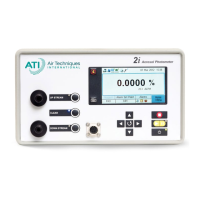Aerosol Photometer
Aerosol Photometer - 2i 17
agent consisting of an airborne test aerosol is
generated and introduced upstream of the filter. The
challenge agent provides particulate matter upstream
of the filter to allow measurements downstream of the
filter.
The test aerosol is introduced into the upstream side
of the filter(s) as far from the filters as is practical to
insure adequate mixing. Ideally, a distance of 10 duct
diameters upstream is considered the minimum. A
sample of the aerosol-air mixture should be taken
from the upstream side, close to the center of the
filter/filter bank. This sample is used to establish a
100% base line for the upstream concentration. The
2i is adjusted as described in the Operating Section to
set the 100% reading and the stray light is adjusted
automatically. The stray light adjustment
compensates for light reflection off internal surfaces of
the scattering chamber. After these adjustments have
been made, the 2i instrument is ready to check for
filter leaks/integrity downstream.
The filter test is performed with the use of the
scanning probe. The filter and the perimeter of the
filter pack should be scanned by passing the probe in
slightly overlapping strokes so the entire area of the
filter is sampled. The end of the probe should be held
one inch from the filter surface. Separate passes
should be made around the entire periphery of the
filter, along the bond between the filter pack and the
frame, and around the seal of the filter. Readings on
the meter will indicate percent of penetration.
The display indicates the percent of leakage through
or around the filter. The iProbe is supplied with the
industry standard rectangular, blue isokinetic nozzle.
This nozzle is used for fast scanning and is accepted
by many standards, including NSF 49-2002.
Other optional probes are available, a round, black 1
inch (25 mm) in diameter nozzle, which complies with
NSF (National Sanitation Foundation) Standard 49-
1992, and a round, red nozzle. The isokinetic nozzles
are designed for face velocities of 90 +/- 20 feet per
minute (fpm) when using a 1 cfm (28.3 L/min) sample
rate.

